Comparative Modelling Analysis of Air Pollutants, PM2.5 and Energy Efficiency Using Three Ventilation Strategies in a High-Rise Building: A Case Study in Suzhou, China
Abstract
:1. Introduction
- (1)
- Which system has the better performance in controlling IAQ in a high-rise building?
- (2)
- Which system is more efficient in terms of improving IAQ in a high-rise building while also saving energy?
2. Methodology
2.1. The Modelled Office Building
2.2. Weather Characteristics of Suzhou
2.3. Indoor Thermal Comfort and Thermal Ventilation Energy
2.4. Estimating the Pressure Drop in the Ventilation System
2.5. Estimate Indoor Particle Concentration
2.6. The Daily Average Outdoor PM2.5 Level in Suzhou
2.7. Particle Concentration Vertical Profiles
3. Results
3.1. The Energy Performance of Three Different Ventilation Strategies
3.2. The Performance of the Ventilation System in Controlling IAQ
3.2.1. The Influence of the AHU Location on the Ventilation Performance
3.2.2. The Seasonal Impact on Ventilation Performance among the Three Systems
3.2.3. The Impact of Air Infiltration Rate and Filter Efficiency on Ventilation Performance
3.2.4. The Comparison of the Ventilation Efficiency among the Three Systems
3.2.5. The Ventilation Performance in Controlling IAQ in a Building
3.3. Improving the System’s Ventilation and Energy Performance
4. Conclusions
Author Contributions
Funding
Institutional Review Board Statement
Informed Consent Statement
Data Availability Statement
Acknowledgments
Conflicts of Interest
References
- WHO. Air Quality Guidelines Global Update 2005: Particulate Matter, Ozone, Nitrogen Dioxide and Sulfur Dioxide; World Health Organization Regional Office for Europe: Geneva, Switzerland, 2006. [Google Scholar]
- WHO. Health Effects of Particulate Matter; World Health Organization: Geneva, Switzerland, 2013. [Google Scholar]
- Chen, G.; Li, S.; Zhang, Y.; Zhang, W.; Li, D.; Wei, X.; He, Y.; Bell, M.L.; Williams, G.; Marks, G.B.; et al. Effects of ambient PM 1 air pollution on daily emergency hospital visits in China: An epidemiological study. Lancet Planet. Health 2017, 1, e221–e229. [Google Scholar] [CrossRef]
- Hu, K.; Guo, Y.; Hu, D.; Du, R.; Yang, X.; Zhong, J.; Fei, F.; Chen, F.; Chen, G.; Zhao, Q.; et al. Mortality burden attributable to PM1 in Zhejiang province, China. Environ. Int. 2018, 121, 515–522. [Google Scholar] [CrossRef] [PubMed]
- Zauli-Sajani, S.; Rovelli, S.; Trentini, A.; Bacco, D.; Marchesi, S.; Scotto, F.; Zigola, C.; Lauriola, P.; Cavallo, D.M.; Poluzzi, V.; et al. Higher health effects of ambient particles during the warm season: The role of infiltration factors. Sci. Total Environ. 2018, 627, 67–77. [Google Scholar] [CrossRef] [PubMed]
- Yang, B.-Y.; Guo, Y.; Morawska, L.; Bloom, M.S.; Markevych, I.; Heinrich, J.; Dharmage, S.C.; Knibbs, L.D.; Lin, S.; Yim, S.H.L.; et al. Ambient PM1 air pollution and cardiovascular disease prevalence: Insights from the 33 Communities Chinese Health Study. Environ. Int. 2019, 123, 310–317. [Google Scholar] [CrossRef] [PubMed]
- EPA. Health and Environmental Effects of Particulate Matter (PM); 2019. Available online: https://www.epa.gov/pm-pollution/health-and-environmental-effects-particulate-matter-pm (accessed on 11 May 2019).
- Li, A.; Ren, T.; Yang, C.; Lv, W.; Zhang, F. Study on particle penetration through straight, L, Z and wedge-shaped cracks in buildings. Build. Environ. 2017, 114, 333–343. [Google Scholar] [CrossRef]
- Pereira, M.; Graudenz, G.; Tribess, A.; Morawska, L. Determination of particle concentration in the breathing zone for four different types of office ventilation systems. Build. Environ. 2009, 44, 904–911. [Google Scholar] [CrossRef] [Green Version]
- Chen, C.; Zhao, B. Review of relationship between indoor and outdoor particles: I/O ratio, infiltration factor and penetration factor. Atmos. Environ. 2011, 45, 275–288. [Google Scholar] [CrossRef]
- Challoner, A.; Gill, L. Indoor/outdoor air pollution relationships in ten commercial buildings: PM2.5 and NO2. Build. Environ. 2014, 80, 159–173. [Google Scholar] [CrossRef]
- Peng, Z.; Deng, W.; Tenorio, R. Investigation of Indoor Air Quality and the Identification of Influential Factors at Primary Schools in the North of China. Sustainability 2017, 9, 1180. [Google Scholar] [CrossRef]
- Ben-David, T.; Wang, S.; Rackes, A.; Waring, M.S. Measuring the efficacy of HVAC particle filtration over a range of ventilation rates in an office building. Build. Environ. 2018, 144, 648–656. [Google Scholar] [CrossRef]
- Zhang, C.; Wang, J.; Li, L.; Wang, F.; Gang, W. Utilization of Earth-to-Air Heat Exchanger to Pre-cool/heat Ventilation Air and Its Annual Energy Performance Evaluation: A Case Study. Sustainability 2020, 12, 8330. [Google Scholar] [CrossRef]
- Rieser, A. Integration of Energy-Efficient Ventilation Systems in Historic Buildings-Review and Proposal of a Systematic Intervention Approach. Sustainability 2021, 13, 2325. [Google Scholar] [CrossRef]
- Kim, M.K.; Baldini, L.; Leibundgut, H.; Wurzbacher, J.A.; Piatkowski, N. A novel ventilation strategy with CO2 capture device and energy saving in buildings. Energy Build. 2015, 87, 134–141. [Google Scholar] [CrossRef]
- Sundell, J.; Levin, H.; Nazaroff, W.; Cain, W.S.; Fisk, W.J.; Grimsrud, D.T.; Gyntelberg, F.; Li, Y.; Persily, A.K.; Pickering, A.C.; et al. Ventilation rates and health: Multidisciplinary review of the scientific literature. Indoor Air 2011, 21, 191–204. [Google Scholar] [CrossRef] [PubMed]
- Azimi, P.; Zhao, D.; Stephens, B. Estimates of HVAC filtration efficiency for fine and ultrafine particles of outdoor origin. Atmos. Environ. 2014, 98, 337–346. [Google Scholar] [CrossRef]
- Carrer, P.; Wargocki, P.; Fanetti, A.; Bischof, W.; Fernandes, E.D.O.; Hartmann, T.; Kephalopoulos, S.; Palkonen, S.; Seppänen, O. What does the scientific literature tell us about the ventilation–health relationship in public and residential buildings? Build. Environ. 2015, 94, 273–286. [Google Scholar] [CrossRef]
- Zhao, D.; Azimi, P.; Stephens, B. Evaluating the Long-Term Health and Economic Impacts of Central Residential Air Filtration for Reducing Premature Mortality Associated with Indoor Fine Particulate Matter (PM2.5) of Outdoor Origin. Int. J. Environ. Res. Public Health 2015, 12, 8448–8479. [Google Scholar] [CrossRef] [PubMed] [Green Version]
- Chan, W.R.; Parthasarathy, S.; Fisk, W.J.; McKone, T.E. Estimated effect of ventilation and filtration on chronic health risks in U.S. offices, schools, and retail stores. Indoor Air 2016, 26, 331–343. [Google Scholar] [CrossRef]
- Stephens, B. Evaluating the Sensitivity of the Mass-Based Particle Removal Calculations for HVAC Filters in ISO 16890 to Assumptions for Aerosol Distributions. Atmosphere 2018, 9, 85. [Google Scholar] [CrossRef] [Green Version]
- Kim, M.K.; Choi, J.-H. Can increased outdoor CO2 concentrations impact on the ventilation and energy in buildings? A case study in Shanghai, China. Atmos. Environ. 2019, 210, 220–230. [Google Scholar] [CrossRef]
- Ruan, T.; Rim, D. Indoor air pollution in office buildings in mega-cities: Effects of filtration efficiency and outdoor air ventilation rates. Sustain. Cities Soc. 2019, 49, 101609. [Google Scholar] [CrossRef]
- Kim, M. Introduction of decentralized ventilation systems in buildings. In Sustainable Buildings and Structures; CRC Press: Delft, The Netherlands, 2015; pp. 207–210. [Google Scholar]
- Kim, M.K.; Baldini, L. Energy analysis of a decentralized ventilation system compared with centralized ventilation systems in European climates: Based on review of analyses. Energy Build. 2016, 111, 424–433. [Google Scholar] [CrossRef]
- BINE Informationsdienst. Decentralized Ventilation and Climate Control of Office Buildings, 13/2009; FIZ: Karlsruhe, Germany, 2009; ISSN 0937-8367. [Google Scholar]
- Baldini, L. Advanced Building Ventilation System Based on the Paradigms of Decentralization and Exergy Minimization Using a Highly Interlaced Network Structure for the Supply and a Sensor Based Local Control Approach for the Exhaust; ETH Zurich Library: Zurich, Switzerland, 2009. [Google Scholar]
- Mahler, B.; Himmler, R. Results of the evaluation study DeAL decentralized facade integrated ventilation systems. In Proceedings of the Eighth International Conference for Enhanced Building Operations, Berlin, Germany, 20–22 October 2008. [Google Scholar]
- Cui, S.; Kim, M.K.; Papadikis, K. Performance Evaluation of Hybrid Radiant Cooling System Integrated with Decentralized Ventilation System in Hot and Humid Climates. Procedia Eng. 2017, 205, 1245–1252. [Google Scholar] [CrossRef]
- Kim, M.K.; Liu, J.; Cao, S.-J. Energy analysis of a hybrid radiant cooling system under hot and humid climates: A case study at Shanghai in China. Build. Environ. 2018, 137, 208–214. [Google Scholar] [CrossRef]
- CTBUH. Tall Buildings in Numbers: 2017 Year in Review; Council on Tall Buildings and Urban Habitat: Chicago, IL, USA, 2017. [Google Scholar]
- Kalaiarasan, M. Traffic-generated airborne particles in naturally ventilated multi-storey residential buildings of Singapore: Vertical distribution and potential health risks. Build. Environ. 2009, 44, 1493–1500. [Google Scholar] [CrossRef]
- Zhang, Y.-F.; Xu, H.; Tian, Y.-Z.; Shi, G.-L.; Zeng, F.; Wu, J.; Zhang, X.-Y.; Li, X.; Zhu, T.; Feng, Y.-C. The study on vertical variability of PM10 and the possible sources on a 220 m tower, in Tianjin, China. Atmos. Environ. 2011, 45, 6133–6140. [Google Scholar] [CrossRef]
- Xiao, Z.; Wu, J.; Han, S.; Zhang, Y.; Xu, H.; Zhang, X.; Shi, G.; Feng, Y. Vertical characteristics and source identification of FM10 in Tianjin. J. Environ. Sci. 2012, 24, 112–115. [Google Scholar] [CrossRef]
- Deng, X.; Li, F.; Li, Y.; Li, J.; Huang, H.; Liu, X. Vertical distribution characteristics of PM in the surface layer of Guangzhou. Particuology 2015, 20, 3–9. [Google Scholar] [CrossRef]
- Peng, Z.-R.; Wang, D.; Wang, Z.; Gao, Y.; Lu, S. A study of vertical distribution patterns of PM2.5 concentrations based on ambient monitoring with unmanned aerial vehicles: A case in Hangzhou, China. Atmos. Environ. 2015, 123, 357–369. [Google Scholar] [CrossRef]
- Azimi, P.; Zhao, H.; Fazli, T.; Zhao, D.; Faramarzi, A.; Leung, L.; Stephens, B. Pilot study of the vertical variations in outdoor pollutant concentrations and environmental conditions along the height of a tall building. Build. Environ. 2018, 138, 124–134. [Google Scholar] [CrossRef]
- Liu, F.; Zheng, X.; Qian, H. Comparison of particle concentration vertical profiles between downtown and urban forest park in Nanjing (China). Atmos. Pollut. Res. 2018, 9, 829–839. [Google Scholar] [CrossRef]
- Wong, P.P.; Lai, P.-C.; Allen, R.; Cheng, W.; Lee, M.; Tsui, A.; Tang, R.; Thach, T.Q.; Tian, L.; Brauer, M.; et al. Vertical monitoring of traffic-related air pollution (TRAP) in urban street canyons of Hong Kong. Sci. Total Environ. 2019, 670, 696–703. [Google Scholar] [CrossRef] [PubMed] [Green Version]
- Stephens, B.A.; Parham, L.L. How do outdoor pollutant concentration vary along the height of a tall building? CTBUH J. 2019, 7, 26–32. [Google Scholar]
- Wang, J. Suzhou Daily Average Outdoor Dry-Bulb Air Temperature from 1st of January 2018 to 31st of December 2018. Available online: https://www.aqistudy.cn/ (accessed on 21 September 2019).
- ANSI/ASHRAE Standard 62. 1, Ventilation for Acceptable Indoor Air Quality (ASHRAE 2010b); American Society of Heating, Refrigerating and Air-Conditioning Engineers, Inc.: Atlanta, GA, USA, 2013. [Google Scholar]
- WUI. Shanghai Hongqiao International Airport Station; 2021. Available online: https://www.wunderground.com/history/daily/cn/ (accessed on 21 September 2019).
- ANSI/ASHRAE Standard 55, Thermal Environmental Conditions for Human Occupancy (ASHRAE 2010a); American Society of Heating, Refrigerating and Air-Conditioning Engineers, Inc.: Atlanta, GA, USA, 2010.
- Muralikrishna, I.V.; Manickam, V. Chapter Fourteen—Air Pollution Control Technologies. In Environmental Management: Science and Engineering for Industry; Butterworth-Heinemann: Oxford, UK; Cambridge, MA, USA, 2017; pp. 337–397. [Google Scholar]
- Niu, J.; Zhang, L.; Zuo, H. Energy savings potential of chilled-ceiling combined with desiccant cooling in hot and humid climates. Energy Build. 2002, 34, 487–495. [Google Scholar] [CrossRef]
- Zhang, L.Z.; Niu, J.L. Indoor humidity behaviors associated with decoupled cooling in hot and humid climates. Build. Environ. 2003, 38, 99–107. [Google Scholar] [CrossRef]
- CIBSE Guide B2. Ventilation and Ductwork; CIBSE Publications: London, UK, 2016. [Google Scholar]
- CEN. BS EN 1886:2007 Ventilation for Buildings. Air Handling Units. Mechanical Performance; BSI Standards Limited: London, UK, 2007. [Google Scholar]
- EngA. Linear HEF-2 Extruded Radiant Ceiling System Design Manual. Available online: http://airtexradiantpanels.com/documents/lineardesign.pdf (accessed on 25 November 2020).
- CEN. BS EN 13779:2007 Ventilation for Non-Residential Buildings. Performance Requirements for Ventilation and Room-Conditioning Systems; BSI standards Limited: London, UK, 2007. [Google Scholar]
- Pope, C.A.; Burnett, R.T.; Thurston, G.D.; Thun, M.J.; Calle, E.E.; Krewski, D.; Godleski, J.J. Cardiovascular Mortality and Long-Term Exposure to Particulate Air Pollution. Circulation 2004, 109, 71–77. [Google Scholar] [CrossRef] [Green Version]
- Miller, K.A.; Siscovick, D.S.; Sheppard, L.; Shepherd, K.; Sullivan, J.H.; Anderson, G.L.; Kaufman, J.D. Long-Term Exposure to Air Pollution and Incidence of Cardiovascular Events in Women. N. Engl. J. Med. 2007, 356, 447–458. [Google Scholar] [CrossRef]
- Liu, D.-L.; Nazaroff, W. Particle Penetration through Building Cracks. Aerosol Sci. Technol. 2003, 37, 565–573. [Google Scholar] [CrossRef] [Green Version]
- Wang, H. Study Shows PM1 Air Pollution Is Most Harmful; 2013. Available online: http://usa.chinadaily.com.cn/china/2013-10/28/content_17061997.htm (accessed on 19 July 2019).
- Huang, W.; Xie, X.; Qi, X.; Huang, J.; Li, F. Determination of Particle Penetration Coefficient, Particle Deposition Rate and Air Infiltration Rate in Classrooms Based on Monitored Indoor and Outdoor Concentration Levels of Particle and Carbon Dioxide. Procedia Eng. 2017, 205, 3123–3129. [Google Scholar] [CrossRef]
- EPA. Indoor Particulate Matter—Indoor Air Quality (IAQ); 2019. Available online: https://www.epa.gov/indoor-air-quality-iaq/indoor-particulate-matter (accessed on 21 September 2019).
- Lisa, C.; Ng, A.M.; Anderw, K.; Persily, S.J. Airflow and Indoor Air Quality Models of DOE Reference Commercial Buildings; National Institute of Standards and Technology: Gaithersburg, MD, USA, 2012. [Google Scholar]
- Li, X.; Wang, J.; Tu, X.; Liu, W.; Huang, Z. Vertical variations of particle number concentration and size distribution in a street canyon in Shanghai, China. Sci. Total Environ. 2007, 378, 306–316. [Google Scholar] [CrossRef] [PubMed]
- Liu, P. Aircraft study of aerosol vertical distributions over Beijing and their optical properties. Tellus B Chem. Phys. Meteorol. 2009, 61, 756–767. [Google Scholar] [CrossRef] [Green Version]
- Hu, R.; Niu, J. A review of the application of radiant cooling & heating systems in Mainland China. Energy Build. 2012, 52, 11–19. [Google Scholar]
- ASHRAE. ASHRAE 52.2-1999—Method of Testing General Ventilation Air-Cleaning Devices for Removal Efficiency by Particle Size (ANSI Approved); American Society of Heating, Refrigerating and Air-Conditioning Engineers, Inc.: Atlanta, GA, USA, 2000. [Google Scholar]
- CEN. BS EN ISO 16890-1:2016 Air Filters for General Ventilation. Technical Specifications, Requirements and Classification System Based Upon Particulate Matter Efficiency (ePM); BSI Standards Limited: London, UK, 2017. [Google Scholar]
- Zhang, L.Z.; Niu, J.L. Energy requirements for conditioning fresh air and the long-term savings with a membrane-based energy recovery ventilator in Hong Kong. Energy 2001, 26, 119–135. [Google Scholar] [CrossRef]
- Liu, X.; Niu, J. An optimal design analysis method for heat recovery devices in building applications. Appl. Energy 2014, 129, 364–372. [Google Scholar] [CrossRef]
- Ministry of Environmental Protection of the Republic of China. Ambient Air Quality Standards (GB 3095-2012); Ministry of Environmental Protection of the Republic of China: Beijing, China, 2012. [Google Scholar]
- ASHRAE. 2017 ASHRAE Handbook: Fundamentals; ASHRAE: New York, NY, USA, 2017. [Google Scholar]
- Fisk, W.J.; Mendell, M.J.; Hotchi, T.; Sullivan, D.P. Is CO2 an Indoor Pollutant? Higher Levels of CO2 May Diminish Decision Making Performance. ASHRAE J. 2013, 55, 6148. [Google Scholar]
- Prignon, M.; Van Moeseke, G. Factors influencing airtightness and airtightness predictive models: A literature review. Energy Build. 2017, 146, 87–97. [Google Scholar] [CrossRef]
- Spiru, P.; Simona, P.L. A review on interactions between energy performance of the buildings, outdoor air pollution and the indoor air quality. Energy Procedia 2017, 128, 179–186. [Google Scholar] [CrossRef]
- CEN. BS EN 15242:2007 Ventilation for Buildings. Calculation Methods for the Determination of Air Flow Rates in Buildings Including Infiltration; BSI Standards Limited: London, UK, 2007. [Google Scholar]
- Bonato, P.; D’Antoni, M.; Fedrizzi, R. Modelling and simulation based analysis of a façade integrated decentralized ventilation unit. J. Build. Eng. 2020, 29, 101183. [Google Scholar] [CrossRef]
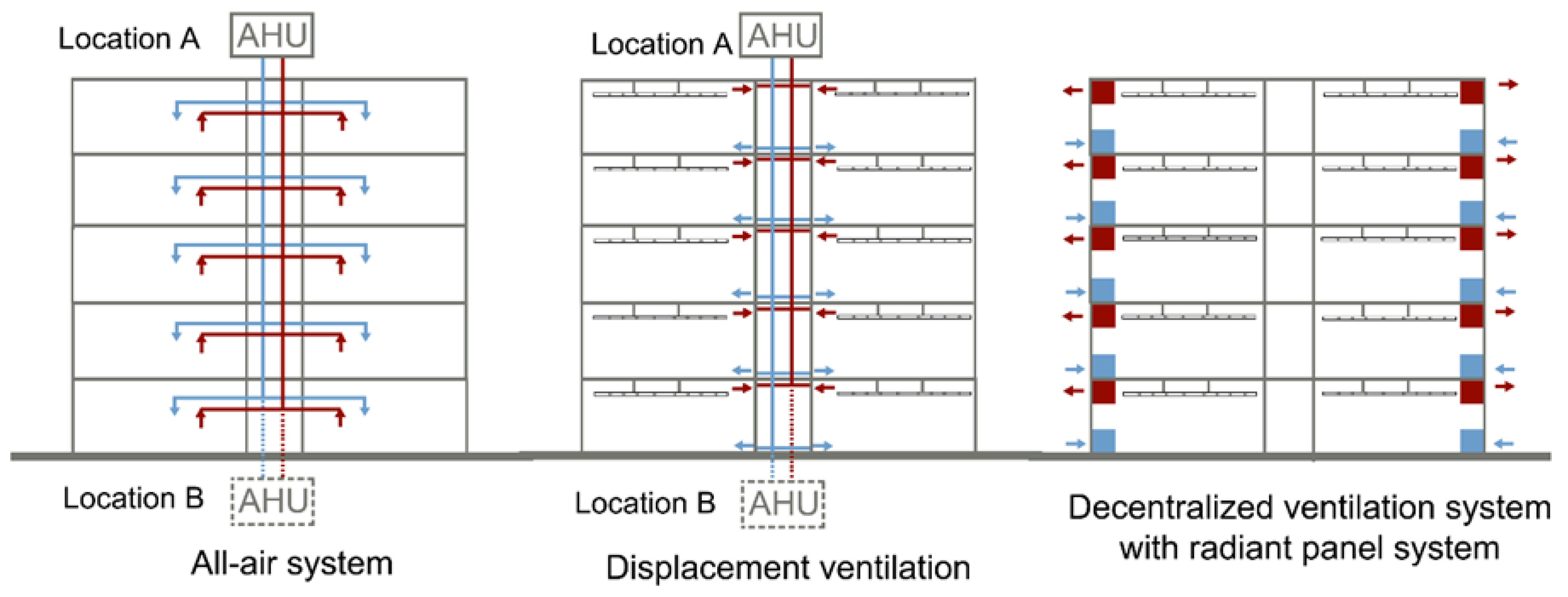
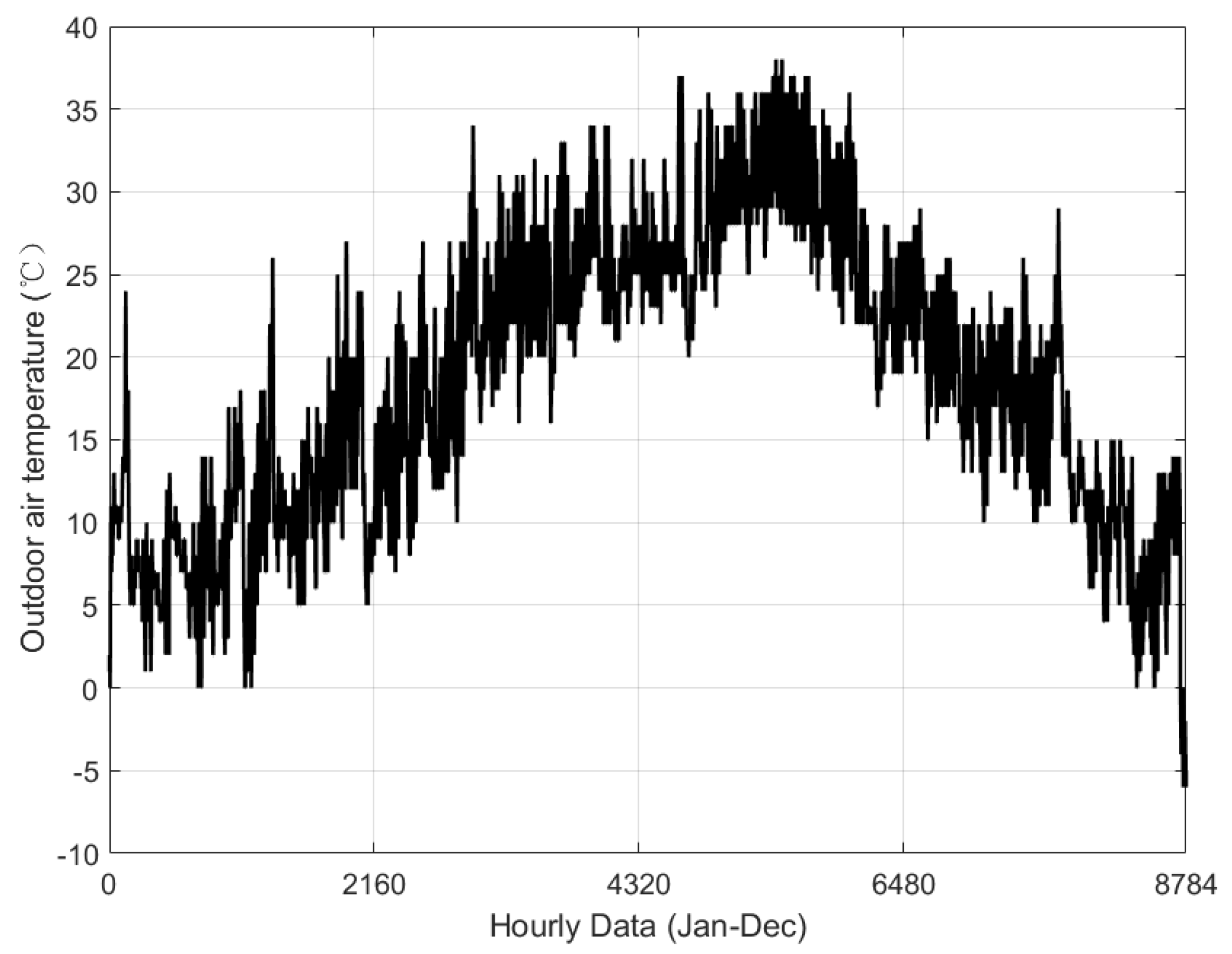
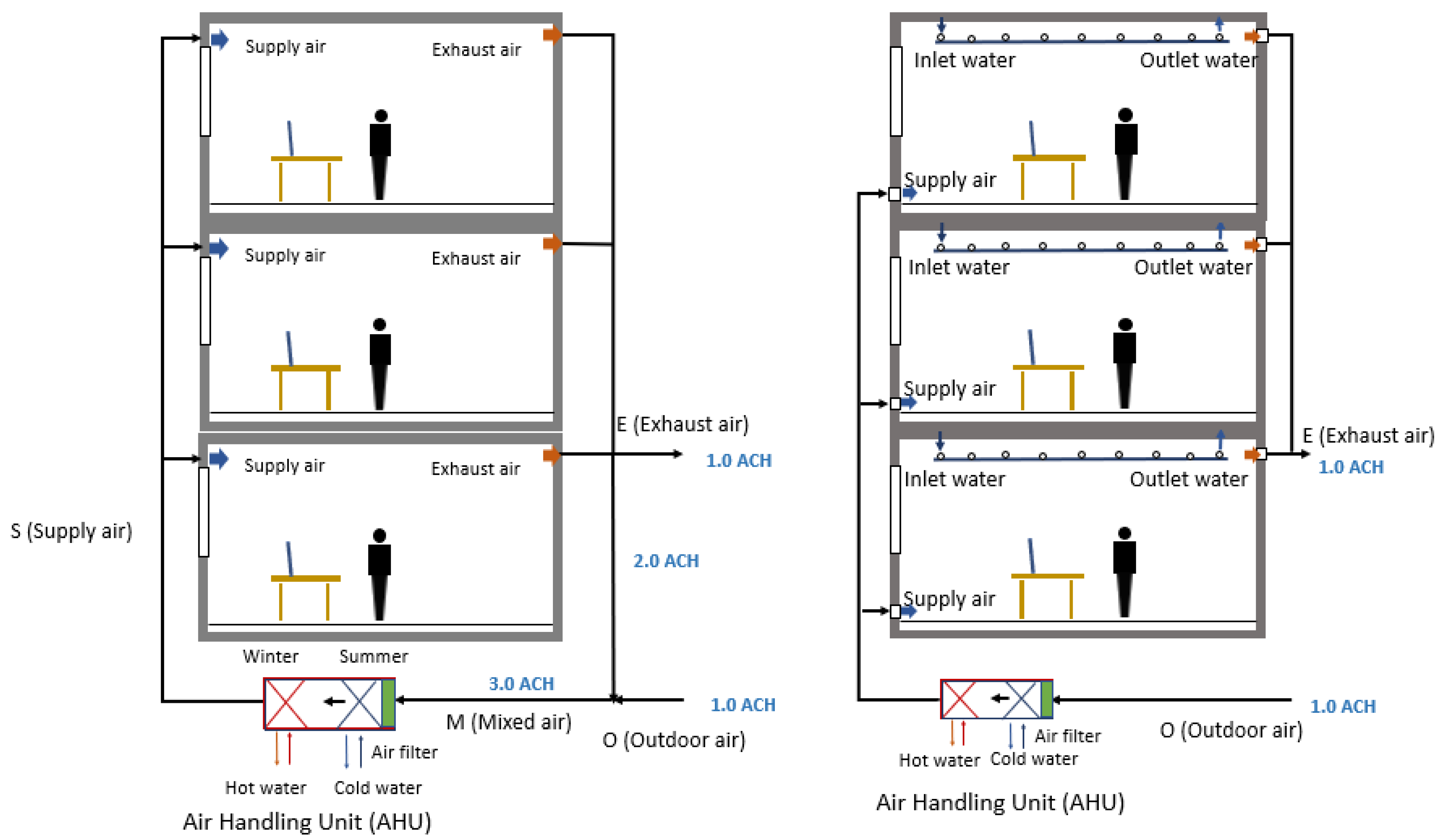
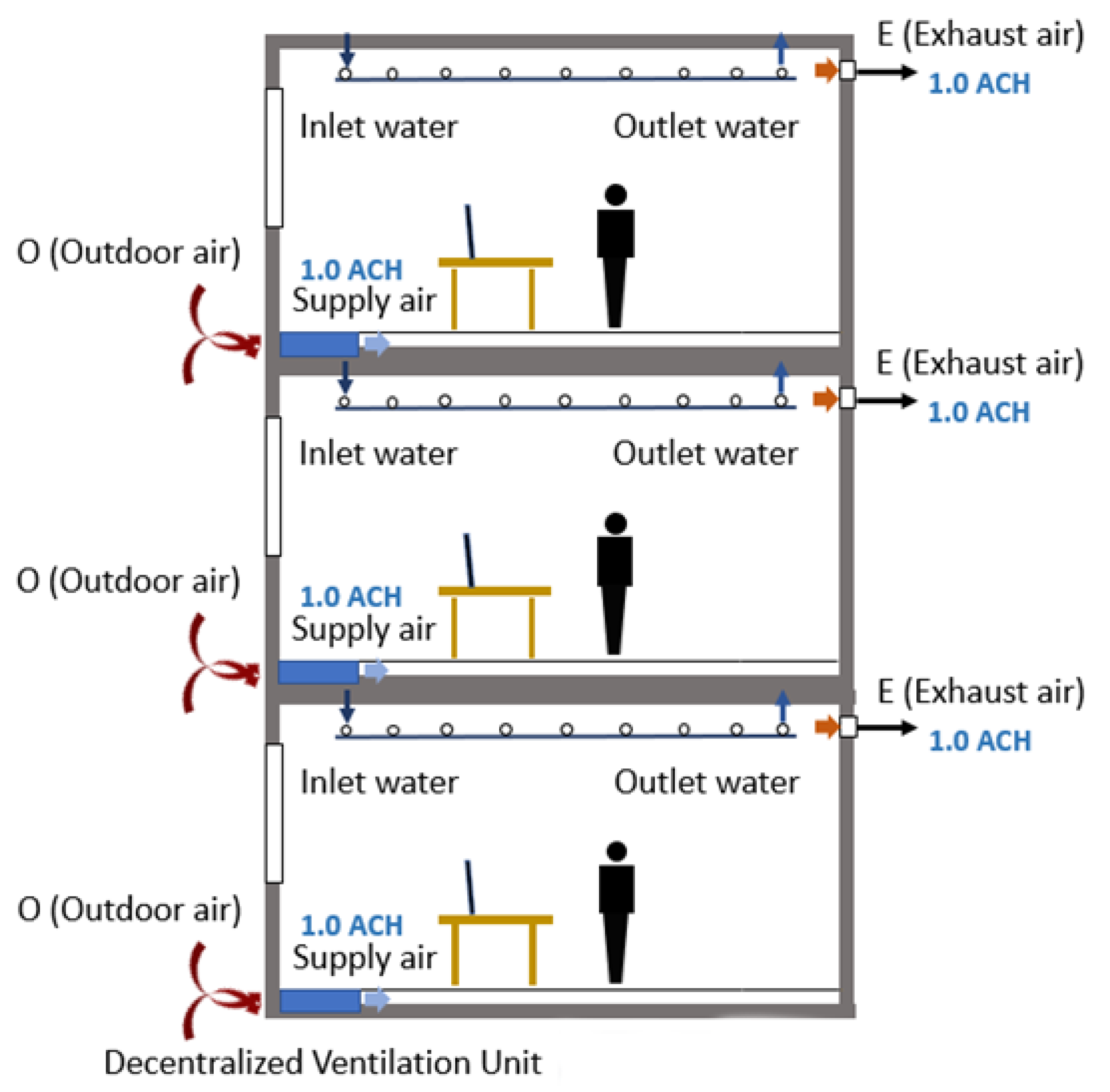
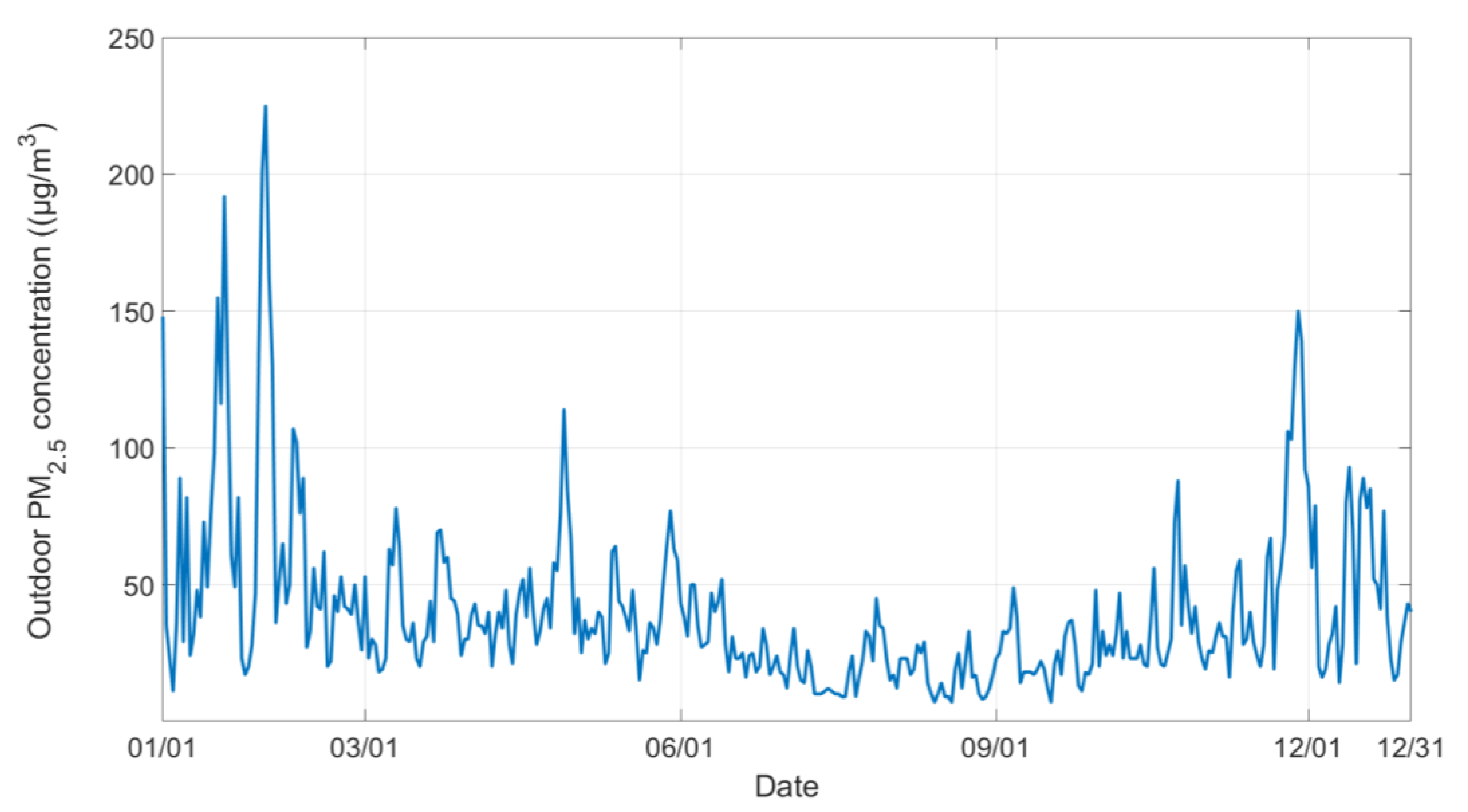
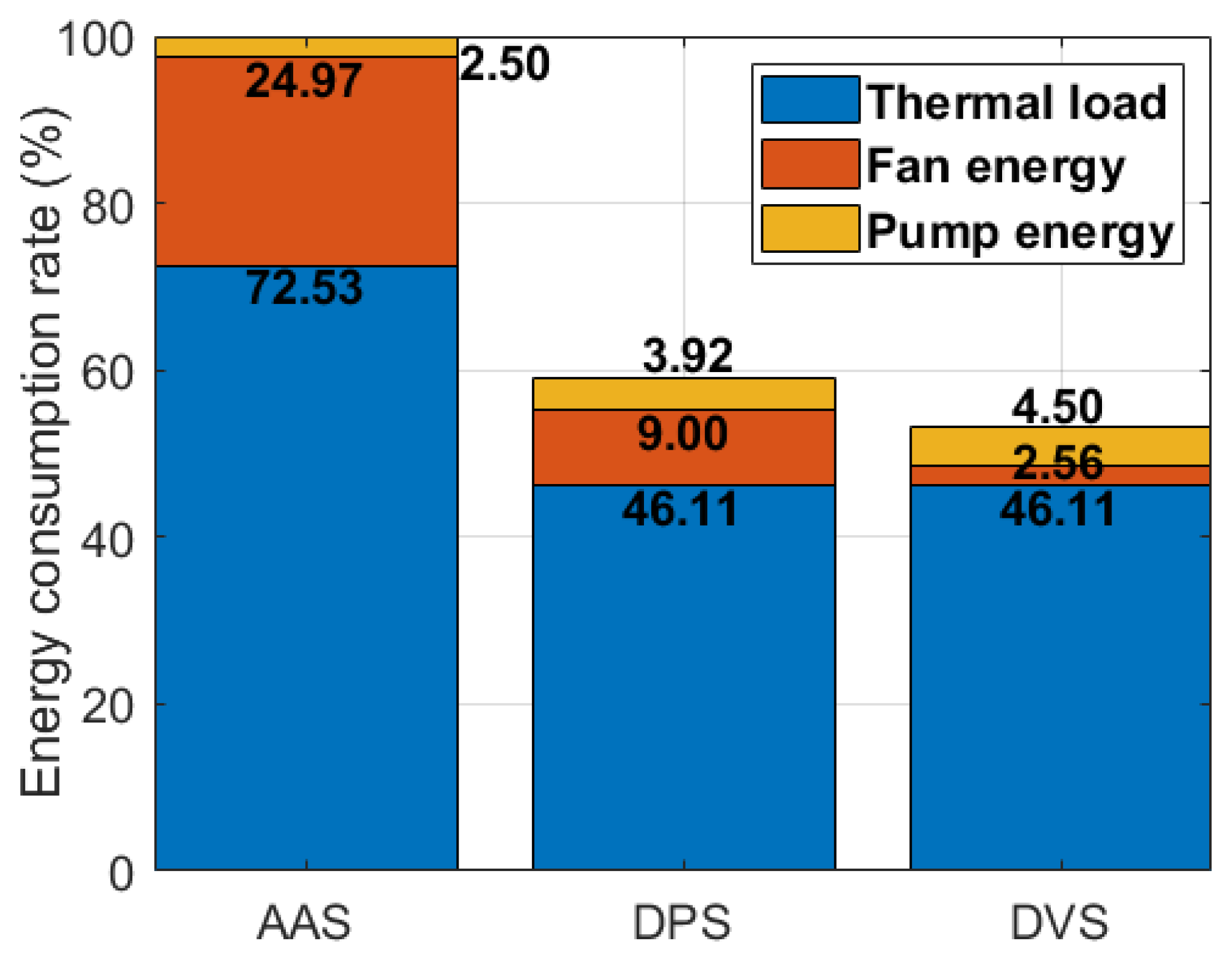
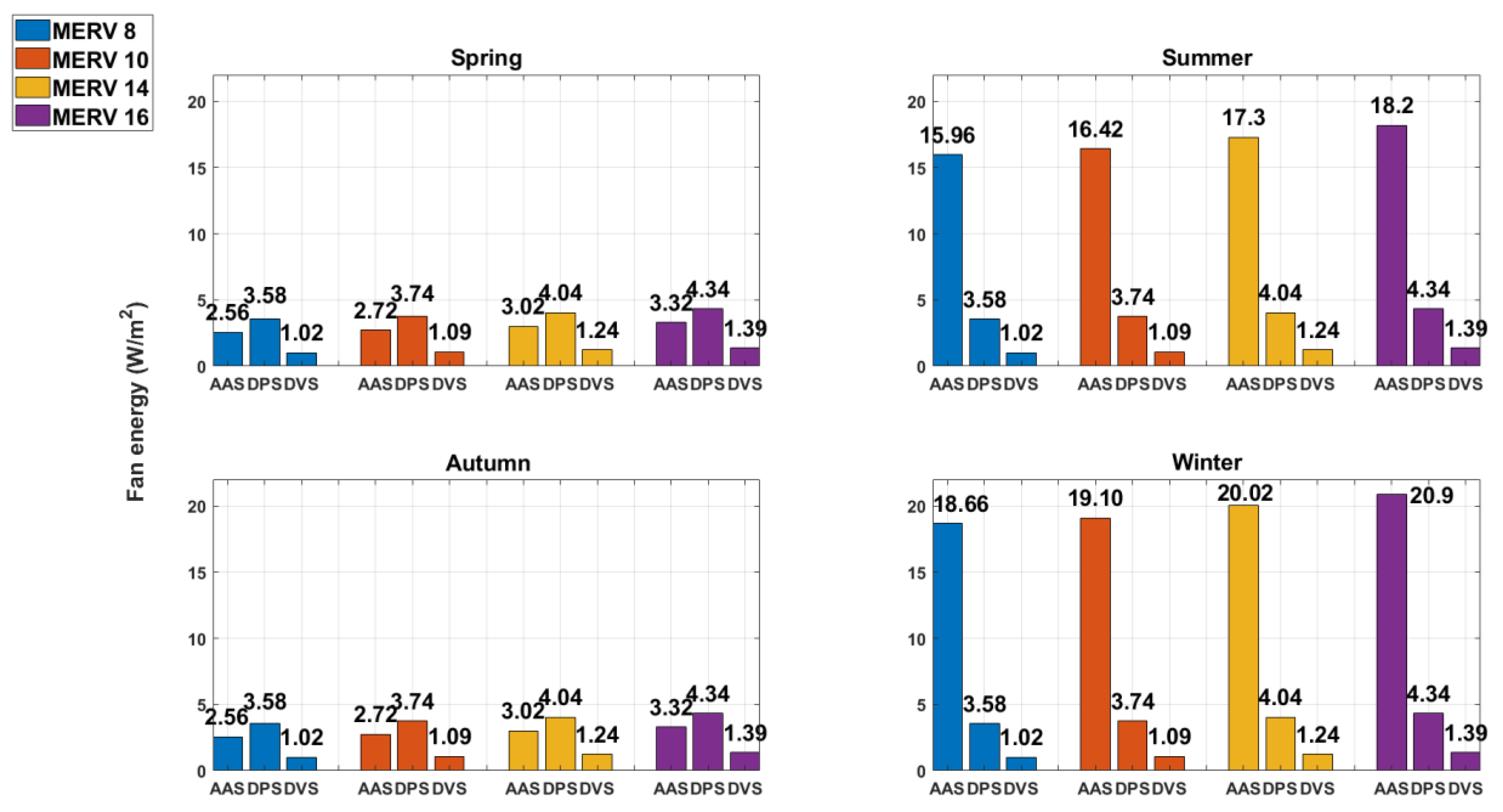

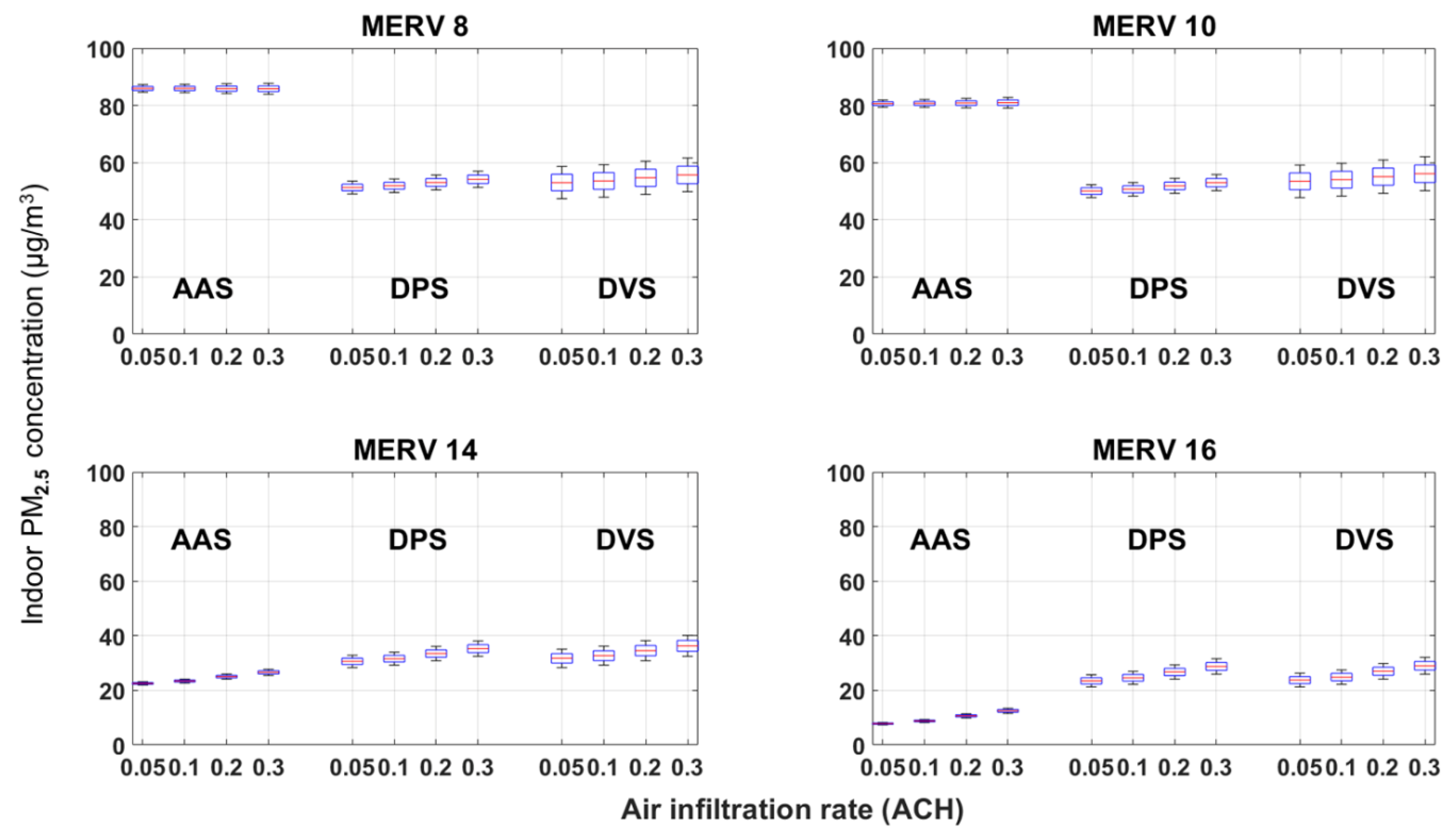
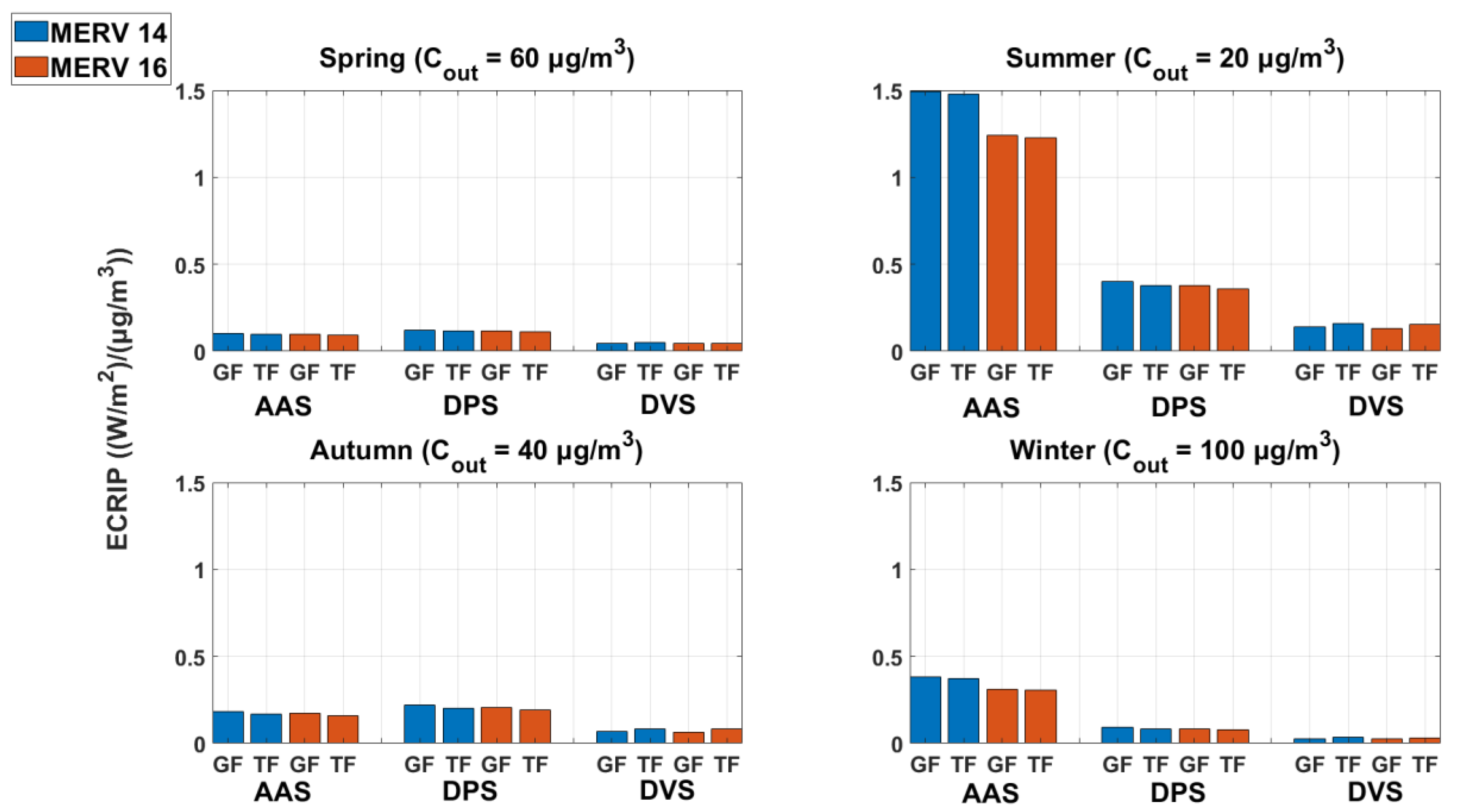

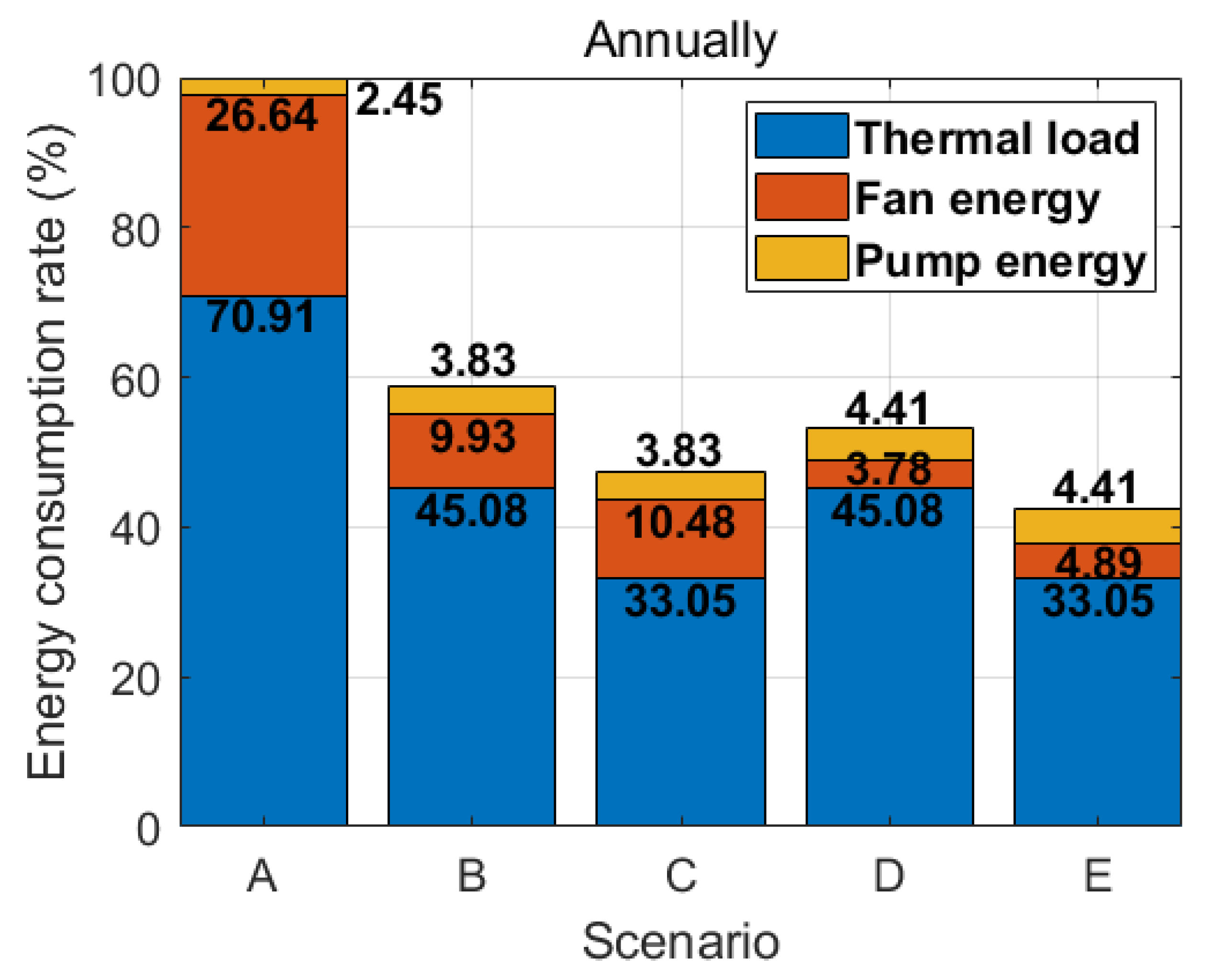
| MERV 8 (Pa) | MERV 10 (Pa) | MERV 14 (Pa) | MERV 16 (Pa) | |
|---|---|---|---|---|
| AAS | 520 | 570 | 670 | 770 |
| AAS (winter with HRU) | 820 | 870 | 970 | 1070 |
| DPS | 520 | 570 | 670 | 770 |
| DVS | 520 | 570 | 670 | 770 |
| Season | p (h−1) | |||||
|---|---|---|---|---|---|---|
| Spring, Summer, Autumn, Winter | 60, 20, 40, 100 | 32.3 (MERV 8) | 0.1 | 0.5 | 0.95 | 0.7 |
| Season | p (h−1) | |||||
|---|---|---|---|---|---|---|
| Winter | 100 | 32.3, 35.4, 78, 95 | 0.05, 0.1, 0.2, 0.3 | 0.5 | 0.95 | 0.7 |
| Ventilation System | Air Filter Class | MERV 8 | MERV 16 | ||
|---|---|---|---|---|---|
| 0.05 | 0.3 | 0.05 | 0.3 | ||
| AAS | 1st floor (µg/m3) | 87.27 | 87.74 | 8.22 | 13.44 |
| 30th floor (µg/m3) | 84.63 | 84.94 | 7.36 | 11.53 | |
| DPS | 1st floor (µg/m3) | 53.56 | 56.99 | 25.73 | 31.60 |
| 30th floor (µg/m3) | 49.06 | 51.33 | 21.23 | 25.93 | |
| DVS | 1st floor (µg/m3) | 40.29 | 44.37 | 26.26 | 32.08 |
| 30th floor (µg/m3) | 32.57 | 35.87 | 21.23 | 25.93 | |
| Ventilation System | MERV 14 (μg/m3) | MERV 16 (μg/m3) | |
|---|---|---|---|
| AAS | Ground floor | 24.05 | 11.03 |
| Top floor | 22.65 | 9.67 | |
| DPS | Ground floor | 23.57 | 13.19 |
| Top floor | 21.66 | 11.29 | |
| DVS | Ground floor | 48.44 | 35.61 |
| Top floor | 39.15 | 28.78 |
| Scenario | System | Filter Configurations | OA Filter | AHU Filter | HRU |
|---|---|---|---|---|---|
| A | AAS | Single filter system | - | MERV 14 | Y |
| B | DPS | Single filter system | - | MERV 14 | N |
| C | DPS | Single filter system | - | MERV 14 | Y |
| D | DVS | Double filter system | MERV 8 | MERV 16 | N |
| E | DVS | Double filter system | MERV 8 | MERV 16 | Y |
| Hint |
| ||||
| Scenario | A | B | C | D | E | |||||
|---|---|---|---|---|---|---|---|---|---|---|
| Building Floor | GF | TF | GF | TF | GF | TF | GF | TF | GF | TF |
| ECRIP (W/m2/(μg/m3) | 0.264 | 0.259 | 0.053 | 0.052 | 0.066 | 0.065 | 0.023 | 0.021 | 0.027 | 0.025 |
Publisher’s Note: MDPI stays neutral with regard to jurisdictional claims in published maps and institutional affiliations. |
© 2021 by the authors. Licensee MDPI, Basel, Switzerland. This article is an open access article distributed under the terms and conditions of the Creative Commons Attribution (CC BY) license (https://creativecommons.org/licenses/by/4.0/).
Share and Cite
Fu, N.; Kim, M.K.; Chen, B.; Sharples, S. Comparative Modelling Analysis of Air Pollutants, PM2.5 and Energy Efficiency Using Three Ventilation Strategies in a High-Rise Building: A Case Study in Suzhou, China. Sustainability 2021, 13, 8453. https://doi.org/10.3390/su13158453
Fu N, Kim MK, Chen B, Sharples S. Comparative Modelling Analysis of Air Pollutants, PM2.5 and Energy Efficiency Using Three Ventilation Strategies in a High-Rise Building: A Case Study in Suzhou, China. Sustainability. 2021; 13(15):8453. https://doi.org/10.3390/su13158453
Chicago/Turabian StyleFu, Nuodi, Moon Keun Kim, Bing Chen, and Stephen Sharples. 2021. "Comparative Modelling Analysis of Air Pollutants, PM2.5 and Energy Efficiency Using Three Ventilation Strategies in a High-Rise Building: A Case Study in Suzhou, China" Sustainability 13, no. 15: 8453. https://doi.org/10.3390/su13158453
APA StyleFu, N., Kim, M. K., Chen, B., & Sharples, S. (2021). Comparative Modelling Analysis of Air Pollutants, PM2.5 and Energy Efficiency Using Three Ventilation Strategies in a High-Rise Building: A Case Study in Suzhou, China. Sustainability, 13(15), 8453. https://doi.org/10.3390/su13158453








